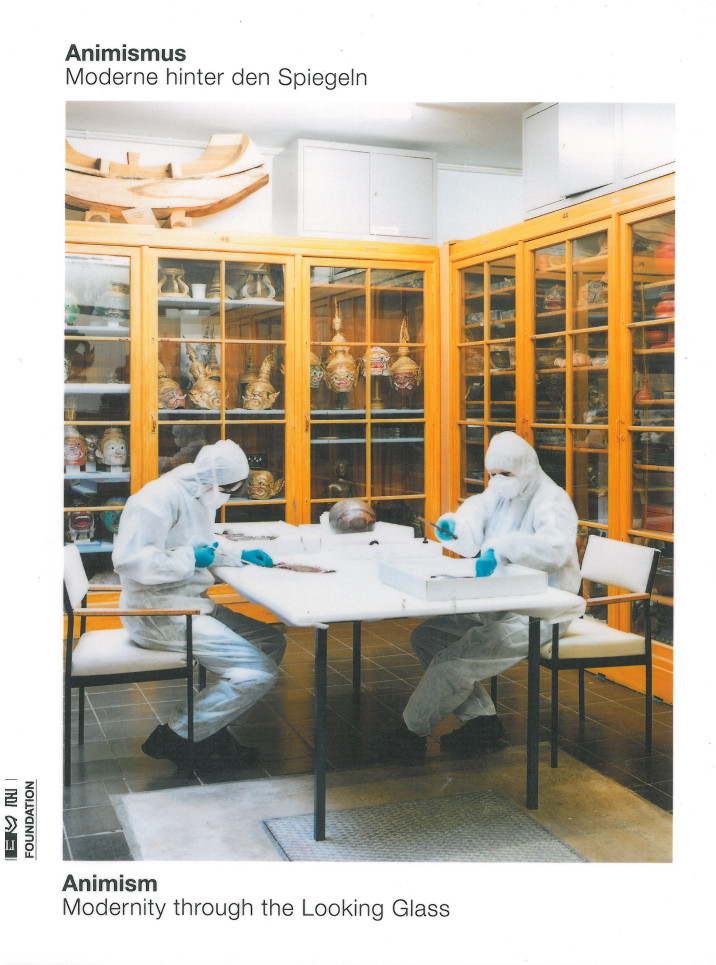Anselm Franke, Sabine Folie (eds.): Animismus: Moderne hinter den Spiegeln / Animism: Modernity through the Looking Glass (2011) [DE/EN]
Filed under catalogue | Tags: · animism, art, colonialism, conceptual art, ethnology, modernity, psychoanalysis

“Animism. Modernity through the Looking Glass takes its cue from the ethnological concept of animism that emerged in the nineteenth century in the context of colonialism in search of a “primal” religion. The term was applied to cultures that view nature and objects as having a soul and a life of their own. This concept borrowed from ethnology also plays a key role in psychoanalysis, where it denotes a mental state in which the inner and outer worlds are not distinct from each other.
The catalogue brings together artworks, documents, and artifacts to create an essayistic visual space that points to the need for a decolonialization and revision of this traditional understanding of animism. The show juxtaposes historical materials such as early attempts to animate technologically reproduced images with contemporary works addressing the line between life and non-life.”
With essays by Sabine Folie, Anselm Franke, Isabelle Stengers, and conversation with Elisabeth von Samsonow by Angela Melitopoulos and Maurizio Lazzarato.
Publisher Generali Foundation, Vienna, and Buchhandlung Walther König, Cologne, 2011
ISBN 9783863350703
229 pages
via cblip
PDF (35 MB)
Comment (0)Philippe Descola: Beyond Nature and Culture (2005–)
Filed under book | Tags: · animism, anthropology, cognitive science, culture, ecology, human, metaphysics, nature, ontology, relation, structuralism, totemism

“Philippe Descola has become one of the most important anthropologists working today, and Beyond Nature and Culture has been a major influence in European intellectual life since its French publication in 2005. At its heart is a question central to both anthropology and philosophy: what is the relationship between nature and culture?
Culture—as a collective human making, of art, language, and so forth—is often seen as essentially different from nature, which is portrayed as a collective of the nonhuman world, of plants, animals, geology, and natural forces. Descola shows this essential difference to be, however, not only a specifically Western notion, but also a very recent one. Drawing on ethnographic examples from around the world and theoretical understandings from cognitive science, structural analysis, and phenomenology, he formulates a new framework, the “four ontologies”— animism, totemism, naturalism, and analogism—to account for all the ways we relate ourselves to nature.”
First published as Par-delà nature et culture, Gallimard, Paris, 2005.
Translated by Janet Lloyd
Foreword by Marshall Sahlins
Publisher University of Chicago Press, 2013
ISBN 0226144453, 9780226144450
xxii+463 pages
Reviews: David Berliner (Anthropological Quarterly, 2010), Des Fitzgerald (Somatosphere, 2013), Gildas Salmon & Pierre Charbonnier (Journal of the Royal Anthropological Institute, 2014), Céline Grandjou (Humanimalia, 2014), Tim Frandy (Journal of Folklore Research, 2014), Michael W. Scott (Anthropology of This Century, 2014), Voytek Lapinski (n.d.).
Book symposium: Lenclud, Helmreich, Feuchtwang, Kapferer, Toren, Lambek, Coelho de Souza, Descola (Journal of Ethnographic Theory, 2014, pp 363-443).
Comment (0)Anselm Franke (ed.): Animism, 1 (2010)
Filed under book | Tags: · aesthetics, animal, animism, art, art history, ethnography, film, nature, spiritualism, things

“What is the role of aesthetic processes in the drawing of the boundaries between nature and culture, humans and things, the animate and inanimate? Structured around the aesthetic processes and effects of animation and mummification, Animism—a companion publication to the long-term exhibition of the same title, which premiered at Extra City Kunsthal Antwerpen in January 2010—brings together artistic and theoretical perspectives that reflect on the boundary between subjects and objects, and the modern anxiety that accompanies the relation between “persons” and “things.”
With works by Agency, Art & Language, Christian W. Braune & Otto Fischer, Marcel Broodthaers, Paul Chan, Tony Conrad, Didier Demorcy, Walt Disney, Lili Dujourie, Jimmie Durham, Eric Duvivier, Harun Farocki, León Ferrari, Christopher Glembotzky, Victor Grippo, Brion Gysin, Luis Jacob, Ken Jacobs, Darius James, Joachim Koester, Zacharias Kunuk, Louise Lawler, Len Lye, Étienne-Jules Marey, Daria Martin, Angela Melitopoulos & Maurizio Lazzarato, Wesley Meuris, Henri Michaux, Santu Mofokeng, Vincent Monnikendam, Tom Nicholson, Otobong Nkanga, Reto Pulfer, Félix-Louis Regnault, Józef Robakowski, Natascha Sadr Haghighian, Paul Sharits, Yutaka Sone, Jan Švankmajer, David G. Tretiakoff, Rosemarie Trockel, Anne-Mie Van Kerckhoven, Dziga Vertov, Klaus Weber, Apichatpong Weerasethakul.”
With contributions by Agency, Irene Albers, Oksana Bulgakowa, Edwin Carels, Bart De Baere, Didier Demorcy, Brigid Doherty, Sergei Eisenstein, Anselm Franke, Masato Fukushima, Avery F. Gordon, Richard William Hill, Darius James, Gertrud Koch, Joachim Koester, Bruno Latour, Maurizio Lazzarato and Angela Melitopoulos, Vivian Liska, Henri Michaux, Santu Mofokeng, Philippe Pirotte, Florian Schneider, Erhard Schüttpelz, Michael Taussig, Eduardo Viveiros de Castro, Martin Zillinger.
Publisher Sternberg Press, Berlin, with Extra City – Kunsthal Antwerpen and M HKA – Museum of Contemporary Art, Antwerp, 2010
ISBN 9781933128955
256 pages
via chickpou
PDF (7 MB, updated on 2019-1-15)
Exhibition booklets: Muhka (EN), Muhka (NL), HKW (EN), HKW (DE).

